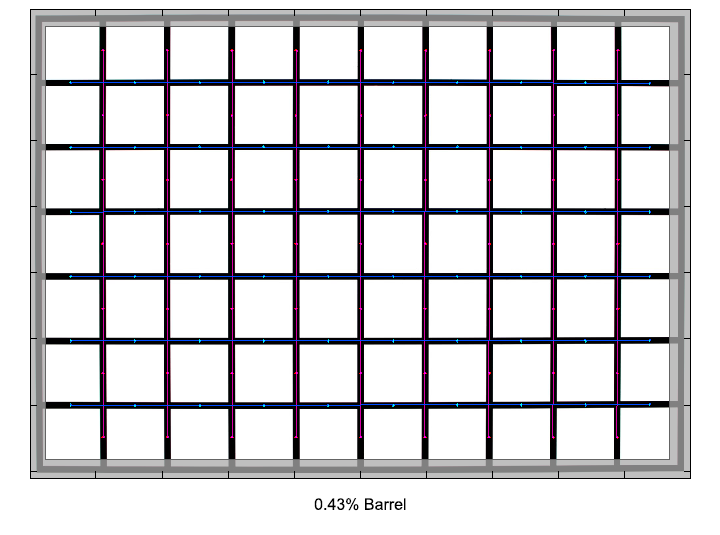|
Page 2 of 2

Distortion
On DX, the Tamron SP 35mm f/1.8 Di VC USD produces a small amount of barrel distortion of ~0.4 %, which is unnoticeable for most photographic subjects.

The chart above has a real-world size of about 120x80cm.
Vignetting
Being a full frame lens, the Tamron takes advantage of the smaller sensor area of the DX camera when it comes to vignetting. Wide open, there is a very moderate amount of light fall-off (~0.6 EV) towards the corners. As usual, stopping down reduces the amount of vignetting considerably. At f/2.8 already it should no longer be an issue for most scenes.

MTF (resolution)
The Tamron delivered decent results in the MTF lab. The center resolution is very good even at the maximum aperture, increasing to excellent values when stopping down. The borders in the DX frame are very good throughout the whole tested aperture range. The corner quality is visibly softer wide open, but also improves to very good values from f/2.8 onwards.
The field curvature is low. The centering quality of the tested sample was ok (albeit not great).
It is worth mentioning that the lens showed no visible focus shifting when stopping down (residual spherical aberration).
Please note that the MTF results are not directly comparable across the different systems!
Below is a simplified summary of the formal findings. The chart shows line widths per picture height (LW/PH) which can be taken as a measure for sharpness.
If you want to know more about the MTF50 figures you may check out the corresponding Imatest Explanations

Chromatic Aberrations (CAs)
Chromatic aberrations (color shadows at harsh contrast transitions) are very low wide open, increasing to moderate readings around 0.8 pixel width at the image borders at medium and small apertures.

Bokeh
One of the primary usage scenarios for a large aperture lens is to isolate the main subject from the fore- & background via a shallow depth-of-field. The quality of the bokeh (out-of-focus blur) is of major significance for the overall impression of such images.
The Tamron SP 35mm f/1.8 Di VC USD provided fairly good results within the scope of a 35mm lens. The general out-of-focus blur is quite smooth both in the foreground as well as in the more important image background, with some signs of nervousness in the latter.
Out-of-focus highlights suffer a little from "onion rings". This is usually caused by aspherical elements (the Tamron has 2 of them), however the issue is less pronounced than on a FX camera. There's no outlining effect and the circular disc shape remains intact at smaller apertures.

Bokeh Fringing
Bokeh fringing is a common issue with relatively fast glass. It's visible as halos of different colors in out-of-focus areas - magenta (red + blue) in front of the focus point
and green beyond.
Typical for most fast primes, the Tamron shows noticeable bokeh fringing at large aperture settings, which can of course be reduced by stopping down.
In addition, these shots also illustrate that there is no visible focus shifting when stopping down.
Sample Images
You can find some sample images taken with the Nikon D3x in our Nikon FX review of the lens.
Verdict
The Tamron SP 35mm f/1.8 Di USD VC is a bit difficult to judge. In terms of performance, it does a mostly good job on our DX test camera. The quality of the center region is great even at f/1.8. Borders are very good thoughout the tested aperture range, only the extreme corners are a bit soft wide open, but that can be cured by stopping down a little.
Both image distortion is well controlled. Lateral CAs are very low wide open and increase to higher but still moderate values stopped down. Bokeh fringing isn't quite as impressive though. There's just a little light falloff visible at f/1.8 and very low amounts at f/2.8 and beyond. The general general quality of the bokeh is quite smooth for a 35mm lens and also out-of-focus highlights are ok (and way less unpleasant than on FX).
Tamron made a substantial step forward in terms of build quality. In the past we weren't all that impressed really but the new design feels much more sturdy and reassuring. Thumbs up here for sure. The AF is both fast and silent. The VC (Vibration Control) is a more than welcome feature although it's not overly efficient based on our experience with the lens.
So where does this leave the lens in the grand scheme of things ? In terms of other FX lenses, the main competition is Nikon's AF-S 35mm f/1.8, which has similar specs but comes at a slightly lower price. Taking the the Tamron's price into account, it also competes with the faster Sigma Art 35mm f/1.4 DG, which retails for roughly 100 EUR more while offering a noticeably faster aperture. The main competitor on DX though is Nikon's AF-S DX 35mm f/1.8 lens, which lacks the optical stabilization, but comes in a much smaller and lighter (though admittedly less sturdy) package and most of all at a fraction of the Tamron's price.
So, on DX the Tamron only makes sense in a dual-use environment with both FX and DX cameras, but even then it still competes with other FX lenses that have either speed, performance or price advantages.
|